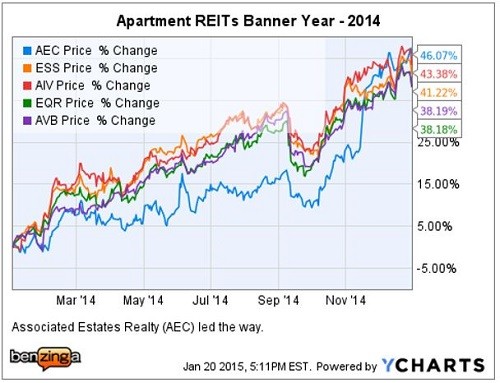Outlook for Apartment REITs in 2014
Post on: 19 Июнь, 2015 No Comment

By David P. Lari and Adriana A. Vesci, Cox, Castle & Nicholson LLP
Modeled after mutual funds, a REIT is a special form of tax-advantaged entity created to pool the capital of numerous investors, allowing individual investors to earn a share of the income produced through real estate ownership, without having to directly buy or finance property or assets. Since the inception of REITs in the 1960s, the industry has grown to include companies specializing in ownership of apartments, hotels and resorts, office buildings, industrial facilities, self-storage facilities, shopping malls, warehouses, healthcare facilities, and even mortgages and loans.
By law, REITs are required to have most of their assets and income tied to real estate investments and must distribute at least 90 percent of their annual taxable income to shareholders in the form of dividends. Accordingly, REITs typically offer better yields than other income investments. For example, average equity yields on REITs at the end of 2013 were 3.7 percent (according to the industry trade group, the National Association of Real Estate Investment Trusts (NAREIT)), compared to 2.6 percent for 10-year Treasury notes.
For three straight years, from 2010 through 2012, REITs provided investors with annualized returns of approximately 17.8 percent, compared to 10.9 percent for the S&P 500, according to American Assets Investment Management. As a result of these strong returns, money flowed into the REIT sector and REIT returns increased during the first half of 2013 by 17.6 percent. However, by the end of 2013, REITs had provided investors with a meager 2.7 percent annualized return, as measured by the Dow Jones Equity All REIT Total Return index, which tracks 147 publicly traded REITs. When compared to the 32.4 percent return by the S&P index, 2013 seems like a particularly down year for REITs.
Among several factors that influenced the performance of REITs in 2013, including the federal government shutdown and budget cuts imposed by sequestration, interest rate concerns had perhaps the most impact. On May 22, 2013, the Federal Reserve Chairman suggested that the Fed’s $85 billion a-month bond buying program would soon be waning. The threat of rising interest rates immediately affected REIT stocks, with the Dow Jones REIT index falling more than 16% by the end of June 2013.
As a relatively high-yield investment, it is normal for REITs to exhibit sensitivity to changing interest rates. Investors may be less likely to view REITs as attractive if their yields fall more in line with other low-risk investments, such as 10-year Treasury notes. In addition, debt is fundamental to real estate development and operation, so owners are generally sensitive to changes in borrowing costs—rising rates lead to increased mortgage costs, making it more difficult to purchase real estate and more expensive to hold it.
So how will REITs perform in 2014? It may all depend on the strength of the economy. In December, NAREIT reported that Fitch Ratings posted a “stable” outlook for REITS in 2014, with the greatest downside being the possibility of rising interest rates coupled with marginal economic growth. If market rates do rise, but such increases are driven by positive economic indicators, there is a possibility that REIT earnings could soar. Fortunately, there are several factors currently bolstering the economy-a stronger consumer, a firmer housing market and steady job growth. A strengthening economy translates to more business and increased demand and occupancy for both commercial and residential real estate.
Because of the continuing uncertainty in the interest rate environment, it is likely that the $65.5 billion raised by U.S. equity REITs in 2013 will be directed to sectors that are sensitive to an improving economy, including apartments, healthcare facilities and stable single-tenant properties. Apartment REITs in particular appear to be positioned well for growth in the coming months. As the job market continues to improve, several million unformed households in the U.S. (primarily young adults who are financially unable to move out of their parents’ homes) are likely to begin to move into the housing market. As home prices continue to rise, and as home inventory tightens, the more attractive renting may be to the average individual or family. In addition, because of a continuing decline over the past several years in housing starts and permits to construct multifamily rental units, the chance that the supply of rental units will outpace the demand for such units is slim, giving apartment owners more leeway to raise rents.
Interestingly, interest rate fears which generally hurt the REIT industry in 2013 may be an advantage for apartment REITs vis-à-vis REITs focused on other asset classes, such as office and retail. Rising rates have historically led to decreased new home construction and increased mortgage costs. Because declining home ownership boosts demand for apartments, and new supply remains modest in most markets, apartment REITs will continue to benefit from the short-term leases that characterize multi-family properties, allowing owners to offset rising rates as the economy recovers by raising rents more frequently than REITs with properties subject to long-term leases will be able to.
David P. Lari and Adriana A. Vesci are partners in the Los Angeles office of Cox, Castle & Nicholson LLP. David and Adriana represent REITs in a wide variety of real estate matters, including acquisition, disposition, joint venture, financing and development transactions throughout the United States.
Tags: apartment REIT. apartment REIT forecast. REIT














